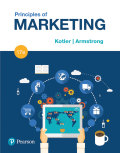
EBK PRINCIPLES OF MARKETING
17th Edition
ISBN: 9780134461427
Author: Armstrong
Publisher: YUZU
expand_more
expand_more
format_list_bulleted
Question
Chapter 20, Problem 20.14AC
Summary Introduction
Case summary:
Company K is the leading grocer-only chain, who sells natural and organic foods. The organic foods are more costly when compared with the natural foods. On an overall study, the average cost of organic foods is 85% more than the conventional foods. However, consumers would not buy the organic option if the costs goes too high.
Characters in given case:
- Company K
To calculate: The number of dozen eggs do a conventional farmer and organic farmers requires to sell at break-even,
Expert Solution & Answer
Want to see the full answer?
Check out a sample textbook solution
Students have asked these similar questions
How can I summarize my Marketing Proposal
1. Product Strategy
Product/Service Description
Our company is launching the ErgoFlex Wireless Keyboard, a high-performance ergonomic keyboard that is suitable for professionals and gamers. It features customizable RGB lighting, lightning-fast Bluetooth connectivity, and a rechargeable long-life battery, providing comfort and productivity for extended use.
Justification for the Need
With the escalating trend of online work and online gaming, consumers experience wrist stress from prolonged typing. Research points out that 70% of working professionals grumble about having aching wrists. ErgoFlex Wireless Keyboard is an answer to greater ease and efficiency in response to demands of modern working professionals and online gamers.
2. Pricing Strategy
We will adopt a value-based pricing strategy, setting the price at $99.99.
Competitor products have comparable keyboards priced at $120+, making it easy for us to brand ours as cheap but…
types of brand strategies used by marketers. Which one strategy could work better than another?
I need answer typing clear urjent no chatgpt used pls i will give 5 Upvotes.full explanation pls
Knowledge Booster
Similar questions
- I need answer typing clear urjent no chatgpt used pls i will give 5 Upvotes.arrow_forwardHello I'm trying to get my money back from my account it was a purchase that was just made today on March 8th 2025 for $19.95 and I have not been using this cuz I'm not in school so if there's a way I can get my money back that would be greatarrow_forwardI need answer typing clear urjent no chatgpt used pls i will give 5 Upvotes.arrow_forward
- I need answer typing clear urjent no chatgpt used pls i will give 5 Upvotes.arrow_forwardI need help with completing the following Been tasked with working as part of a marketing team to perform a 4P analysis to present to your leadership. You will first share the information with the team for feedback and consensus. Marketing Plan Proposal Product Strategy How can I decribe the product or service. Justifing the need for the product or service. Pricing Strategy How can I Explain the cost of the product or service. Placement Strategy How can I Describe the delivery method of the product or service. Promotion Strategy What Propose a process to promote your product or service within the community.arrow_forwardI need answer typing clear urjent no chatgpt used pls i will give 5 Upvotes.arrow_forward
- In your expert opinion, what do you think is the most effective and efficient way for small business owners to promote and market their products/services? Why? How have you seen the use of referrals and word of mouth advertising work to the benefit of a small business owner? Please would you kindly provide some examples. How have these methods worked in reverse (to the disadvantage of the owner but possibly benefit the competition)?arrow_forwardIn your Expert Opinion, How do the risks differ when you start your business using a purely product development process versus a purely customer development process approach? What are the elements that go into a customer profile and why is each one useful? What are some of the ways that you could use secondary research to better understand the various segments of your market and to develop promotional materials?arrow_forwardWhat marketing challenges might arise should a major health care provider stop offering a product or service that is socially popular but economically unprofitable? What marketing elements should be considered before a health care provider eliminates such a product or service?arrow_forward
- Choose a company, conduct an in-depth analysis of the identification of variables that are the target of the company's market segmentation, and provide examples of what the company has done to meet its targetsarrow_forwardTravel agencies lose business because passengers book their flights directly on airline websites. give me suggestion on the possible new business line options for passengers who wish to travel, so that the company can replace the loss of airline ticket sales at the agency.arrow_forwardOne of our favourite products is a mobile phone. One popular brand is the Clear Voice GA8. Theproduct is a midrange mobile handset with amazing features and benefits. Some of the phone’s iconicfeatures include a large 4 GB RAM, 166g weight, a durable Corning Gorilla Glass 3, 25MP cameras, anenhanced octa-core processor, 64GB of internal memory, fast battery charging, and fingerprint sensor.These features make the product an outstanding offering in the midrange phones market. Before itsrelease in 2019, purchasing a handset with similar features was a luxurious venture only left to theelite and wealthy persons in society.The product has a lot of benefits depending on the user. Users enjoy multiple benefits from the ClearVoice GA8. It does not lag due to the inclusion of Mali G72 MP3 in its processor (“A 8,” n.d.). As such,the product allows for the performance of multiple actions simultaneously. The gadget has anexpandable memory of up to 128GB. It, therefore, allows the user to save as…arrow_forward
arrow_back_ios
SEE MORE QUESTIONS
arrow_forward_ios
